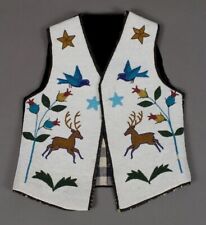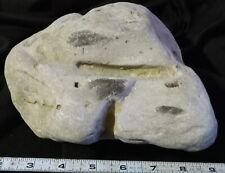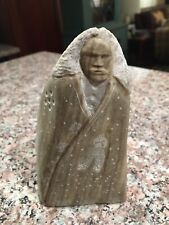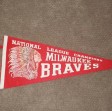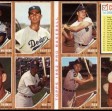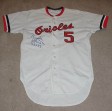When you click on links to various merchants on this site and make a purchase, this can result in this site earning a commission. Affiliate programs and affiliations include, but are not limited to, the eBay Partner Network.
This is an Original Native American Sioux Steel Tipped Arrow from the 19th century. ➡I have been collecting Native American artifacts for many many years. I am selling each piece off one at a time to help save for my retirement. ➡This is a true sale starting at 49.95 with . Don\'t let this original Sioux Steel Tipped Arrow get away. It is one of the more exceptional pieces out of my collection➡Be on the look out for more Native American artifacts in the near future. I will be listing them one at a time.-Continue reading below for history on the arrows that the Native Americans used. ⬇⬇⬇
It\'s a simple and obvious truth that American military men and women no long go off to war fearing fatal injuries from bows and arrows. These days, once-deadly arrowheads have become popular collector’s items. But no so long ago, soldiers in the U.S. Army, including physicians, officers and enlisted men, had to be exceedingly brave to confront American Indians armed with bows and arrows. Even though those basic armaments seem antiquated today, the folks who made and used bows and arrows meant business, and the Army surgeons of the middle 1800s had quite a challenge on their hands. Removing arrowheads from open, gaping wounds that often gushed blood and other body fluids required skill, strength and ingenuity.
Plains Indians painting by Craig Tennant.
American soldiers first deal with arrows and arrowhead wounds in the East, of course, although the Eastern Indians go their hands on firearms soon enough. Among the Western tribes, firearms spread by trade and war. At times, guns proved decisive when groups of Indians had them and their enemies did no. But, because guns were sometimes hard to come by and ammunition scarce, the Plains Indians continued to use bows and arrows in battle well into the second half of the 19th century. For hunting buffalo and other game, bows and arrows were the Indian’s weapon of choice, at least until metallic cartridges became readily available. Many Indians viewed arrows not only as weapons to be used against an enemy or to hunt game but also as sacred gifts from the Creator. For example, Geronimo told one version of the Chiricahua Apache creation myth in which a great bird, the eagle, shared with the Apaches his bow and arrows and even taught them how to use the weapon. A Cheyenne creation myth involves four “Mahuts”, or medicine arrows, given by the creator, Maheo, to Sweet Medicine, who became a prophet of his people. Without the Mahuts there would be no Cheyenne tibe, so these four arrows were guargded in a special tepee by a society of Cheyenne men known as Arrow Keepers. There were earlier weapons such as spears and “atlatl”, or darts, but they seem to have been left out of the various creation myths.
Four examples of Plains Indian arrows, two with metal points and two with chipped stone points. Arrowheads were also made out of antlers, shells, hardwood or bones.
Traditional healers who incorporated arrows in healing rituals were particularly powerful, for in many ancient beliefs, arrows represented the Creator. In the Chemehuevi way, for example, an “arrow shaman” was a medicine man who could cure arrow wounds with “arrow medicine.” This healer was viewed as being stronger than most other medicine men because of his special connection with the Creator. Neighboring tribes, such as the Yumas, also used the services of the Chemehuevi arrow shamans. When Pima Indians were wounded or sick, native healers tried to cure them by shooting arrows at imaginary evil spirits supposedly hung all around the patients. Modoc healers stuck special arrows into the ground near a patient to keep the patient’s soul intact and scare away the disease.
Whatever their association with the Creator or shamans, arrows were first and foremost practical weapons. Indians could unleash them accurately at 100 or more yards and faster than a soldier could fire a musket or a single-shot rifle. From the middle 1700s onward, the Comanches had firearms, but they continued to use bows and iron-tipped arrows when they shot from horseback, possibly because those weapons were noiseless and allowed the shooters to slip away from an ambush without revealing their location. In 1868, author Richard Perry wrote that “the bow and arrow in the hands of skillful warriors proves very deadly; it makes no noise and for night attacks or the taking of sentinels, it is far superior to the gun. Secondly, it is the best weapon that can be used in the chase, or more properly, on the hunt, as half a dozen animals may be slain in a herd before their comrades are aware of the fact. Thirdly, they are so light that they can be worn without the slightest sense of encumbrance. Fourthly, they can always be relied on, at close quarters, when other weapons fail, or ammunition, of which they possess limited supplies, gives out.” There was never a shortage of bows and arrows and arrowheads; each of these items was a renewable resource. The arrowheads were usually made from chipped stone (fling, obsidian, etc.), but antlers, shells, hardwood, bones and metal were also used. According to Army officer John G. Burke (1846 – 1896), an Aravaipa Apache could create a flint arrowhead in about 6 ½ minutes. The arrowhead fit into a slot at the end of the shaft and was tied with sinew or rawhide. On occasion, arrowheads were dipped into venom, plant poisons and putrid animal matter, but that kind of enhancement wasn’t really necessary, because the warriors were such skilled bowmen. The actual toxic effect of poison-tipped arrows has always been overplayed by Hollywood. John C. DaCosta, whose book Modern Surgery came out in 1919, said that the Paiutes were the only Indians he knew of who poisoned their arrowheads. In 1862, however, Army doctor J.H. Bill described how Hopi Indians poisoned the points using the rotting livers of small animals and rattlesnake venom.
An unidentified Sioux chief, circa 1868, holds two arrows with long points.
During the Battle of the Little Bighorn, the Plains Indians made good use of firearms, including repeating rifles. But bows and arrows also came in handy against the undermanned 7th Cavalry during those fateful days on June 25 and 26, 1876. Charles Windolph, who earned a Medal of Honor at Reno Hill, later said that about half the warriors used bows and arrows. How many 7th Cavalrymen actually fell to arrows or war lances is not certain. But there were accounts of arrows flying at the Little Bighorn, as when Sioux Chief Gall and his warriors crawled up behind L Troop. They fired arrows at a high trajectory, and many of those arrows came down into the backs of unsuspecting soldiers. Certainly, warriors at this and other battles with the Army found it convenient to shoot arrows from a concealed position, thus riddling the enemy with indirect fire without exposing themselves. J.H. Bill was one of the few 19th-century physicians to write about arrow wounds in any detail. He concluded that arrow wounds healed more quickly in the desert than elsewhere, an unimportant conclusion to some. But, coupled with the fact that arrow wounds were not always, or even usually, fatal despite the skill of Indian bowmen, Dr. Bill’s pronouncement offered some hope, particularly to U.S. Army personnel fighting Southwestern groups like the Chiricahua Apaches and their distant cousins the Navajos. “The upper extremity is oftenmost wounded,” noted Bill, “next comes the abdomen, next the chest, and next the lower extremity.” The preponderance of arm injuries, he added, was caused by soldiers throwing up their arms to protect their heads from flying arrows. Private James Burridge, a 22-year-old soldier attached to Company G, 14th Infantry, was wounded in a battle with Apaches near Bower’s Ranch in Arizona Territory on November 11, 1867. An arrow struck his arm about two inches above the elbow. By early January of the following year, Burridge knew he had a problem. The arm hadn’t healed properly, and a traumatic aneurysm—soft , pulsating and the size of a pigeon’s egg—had formed. The military surgeon told Burridge to apply pressure to the area with his fingers and hold the bloody tumor down. One week later, after he had followed the doctor’s instructions carfully, the “egg” was reduced to half its size. By January 18, the mass had practically disappeared. Burridge returned to active duty on January 20, 1868.
Another case involved a surgeon who was struck in the armpit by an arrow during a fight against Navajos (Navaho arrows, like those of the Utes, were about 2 ½ feet long, while Apache, Comanche, Arapaho, Cheyenne, Kiowa and Pawnee arrows were about 3 inches longer). As was often the case, the shaft came out easily, but the arrowhead remained in the doctor’s body for quite some time. He finally consulted another surgeon, who made a T-shaped incision over the scapula and located the poing. It was so twisted and bent that a great deal of manipulation was necessary to loosen and remove it. Complications in the form of hemorrhage occurred 12 hours after the surgery, but the bleeding was controlled and the wound physician eventually recovered.
Three examples of 19th-century arrows.
Removing arrowheads was often a difficult task, in part because of the construction of the arrows. Most Indians wrapped the stem of the arrowhead with tendons after fitting it snugly into the arrow’s shaft. On contact with the flesh or bone, the sinew was bathed in the victim’s body fluids, which caused the wrap to swell and stretch. Thus, when the shaft was tugged or pulled out by the panicked victim, many times the arrowhead, loosened by body fluids (especially copious amounts of blood), slipped easily out of it’s mooring and remained in the body. Depending on where in the body the arrow struck, muscles might also contract around the arrowhead and hold it so tightly that removing it presented an enormous challenge. In some cases, the surgeon had to be both skillful and creative to devise a method of removal. If the arrowhead hit a bone and became stuck, however, nothing but forcible traction and all the strength the physician possessed couldn’t remove it. Army doctors carried special surgical instruments to remove arrowheads. A wire loop with a long stem could be rigged and inserted into the wound after the physician dilated the wound opening and bistoury—a narrow surgical knife with a straight or curved blade. Splitting muscle and fascia along the arrow’s pathway into the flesh, often using only his fingers, the doctor determined the location of the point by probing the immediate area. After that, the wire, the opposite end of which was threaded into an instrument known as Coghill’s suture twister, was introduced into the tunnel and shoved closer and closer to the embedded arrowhead. When contact was made, the surgeon carefully manipulated the wire loop so that it encircled the point. After the wire was drawn tight and fastened to the handles of the suture twister, the wire was rocked from side to side as traction was generated by the handles of the instrument. If the wire didn’t break, the arrowhead eventually came loose from the bone and could be withdrawn. If the wire broke, the doctor was forced to try the procedure again.
Novel techniques to treat arrow wounds were sometimes used, such as in 1881 after a Comanche arrow struck an Army officer, whose name was not revealed. According to a verbal report of the incident, “The weapon pierced the upper part of the right chest and passed nearly horizontally through the lung, the point protruding at the back between the scapula and the spine.” At the wounded officer’s request, “a silk handkerchief was fastened to the shaft, which was then pushed through his body, dragging the silk after it through the whole extent of the wound.” Although the usefulness of this treatment is puzzling, the valiant soldier recovered and spent many more years on active duty in the Indian wars. Evacuating chest wounds in which an arrowhead was embedded in a rib was often made easier for the surgeon. According to a 19th-century medical journal, by “placing a block or pile of books” on the patient’s chest, forcing the ribs up out of the chest cavity and into the air. The doctor could then more easily get a grip on the missile, yank it out, push the ribs back into the chest, remove the books and suture the wound shut. Tried and true techniques worked as well, particularly in combination with one of the standard treatment methods—enemas. Take for example the case of civilian Salvador Martinez. An arrow entered Martinez’s chest between the fifth and sixth ribs on the right side and exited between the seventh and eight ribs on the left. When physician J.H. Bill saw him, Martinez had already removed the arrow and was vomiting blood. After being hospitalized at Fort Defiance (in Navajo country) and taking half a grain of sulphate of morphia (morphine) at bedtime, the injured man rallied somewhat. The next morning he was given an enema comprising about half a pint of beer essence and 2 ounces of wine whey. He threw up again and was given half a grain of morphine. Enemas, morphine and even iced champagne were part of Martinez’s rocky course of treatment until he died 18 days later. An autopsy revealed a solidified right lung engorged with pus and a left lung with a hole the size of a turkey’s egg, also filled with pus. The arrow had wounded both lungs, the liver and the stomach.
Chief Captain Jack holds his bow and arrow but also has a rifle within easy reach in this Havasupai group picture taken in Arizona around 1885.
Not all injuries as severe as Martinez’s were fatal. Perhaps one of the most incredible recuperations from a serious head wound was reported by Dr. C.C. Gray, an Army surgeon assigned to the Dakotas in the 1860s. Dr. Gray wrote that Private John Krumholz of Company H, 22nd infantry, was wounded at Fort Sully on June 3, 1869, by an arrow that entered his left eye and penetrated the skull for two inches. The soldier was admitted to the fort’s hospital the same day. After he was anesthetized with chloroform, an operation was begun to remove the point. Surgeons sawed nearly all the way through his skull with a Hey’s saw until they reached the arrowhead, which they removed. Krumholz’s postoperative care consisted of rest, a diet low in calories, elevation of the head, applications of cold to the operative site and saline cathartics. The soldier returned to active duty four days later, June 7, 1869!
In another remarkable example, a man named Miguel, a post guide at Fort Union, New Mexico Territory, was hit by the arrow of a Ute Indian. The arrow stuck in the back of his skull. In a frenzy, Miguel yanked on the shaft and removed it. Fortunately for him, a doctor was nearby and immediately created traction on the point, and after some minutes it slid easily out of the man’s head. Miguel turned over, sneezed, got up off ground, thanked the physician and walked away. The next day he complained of a headache. His face was flushed, and his pulse was fast and irregular. The doctor shaved Miguel’s head and applied croton oil and cold compresses. Miguel became delirious, and the doctor, using a popular treatment, bled him until he fainted, thus abruptly interrupting his hallucinations, but only temporarily. That night Miguel went into a frenzy again and had to be bled once more. Clearly, the remedy was correct, for the next morning the patient was much better. He recovered completely in three weeks and was back at his job at his post.
An Apache poses with a couple of his arrows in the 1880s. Soldiers fighting Apaches in the Southwest might have taken small confort in physician J.H. Bill’s observation that arrow wounds healed more quickly in the desert than elsewhere.
When considering the 19th-century medical reports, what staggers the mind is how many men with arrow wounds managed to survive their injuries and go back into battle or on duty. The dedication of frontier military personnel becomes clear. Arrows could be deadly, but at least soldiers pierced by arrows apparently had a fighting chance. At the same time, though evidence is hard to come by, Indians pierced by arrows seemed to benefit from the arrow medicine men. Guns may have ultimately ruled the Old West, but bows and arrows were essential elements in the lives of most Indians and certainly added to the excitement of that era.




